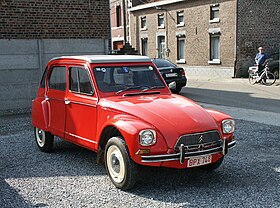Citroën Dyane
| Citroën Dyane | |
|---|---|
 |
|
| Overview | |
| Manufacturer | Citroën |
| Production | 1967–1983 |
| Assembly |
Rennes, France SAIPA, Iran Cimos, Koper, SFR Yugoslavia/Slovenia |
| Body and chassis | |
| Class | Supermini (B) |
| Body style | 5-door hatchback |
| Layout | FF layout |
| Related |
Citroën 2CV Citroën Acadiane Citroën Ami Citroën Méhari Citroën FAF Citroën Bijou |
| Powertrain | |
| Engine | 425 cc Flat-2 435 cc Flat-2 602 cc Flat-2 |
| Dimensions | |
| Wheelbase | 94.5 in (2,400 mm) |
| Length | 153.5 in (3,899 mm) |
| Width | 59 in (1,499 mm) |
| Curb weight | 1,310 lb (594 kg) (approx) |
| Chronology | |
| Predecessor | Citroën 2CV |
| Successor |
Citroën Visa Citroën Axel |
The Citroën Dyane is an economy car/supermini produced by the French automaker Citroën from 1967 to 1983. The design was based on the Citroën 2CV. 1,443,583 were manufactured.
A panel van version called the Acadiane derived from the Dyane.
The Dyane was a development of the Citroën 2CV, and was intended as an answer to the increasingly popular Renault 4, which after its introduction in 1961 had affected 2CV sales. Like the Renault 4, the Dyane was designed from the outset as a hatchback with some other styling differences, such as conventional round headlamps set into the front fender with a squared stainless steel trim ring – as opposed to the old-fashioned separate units found on the 2CV – and stainless steel wheel embellishments as standard. It was and is often asserted that the Dyane was intended to replace the 2CV, but it was nevertheless aimed slightly higher in the Citroën range – between the 2CV and the Ami – and attracted a different clientele seeking the versatility offered by the Dyane's hatchback.
At the time of the Dyane's development, the Citroën design department was busy on updates of the key DS and Ami models: design of the Dyane was therefore initially subcontracted to the Panhard design department, Panhard's non-military business having in 1965 been absorbed into Citroën's car business. The Panhard team under Louis Bioner (who had designed every Panhard model introduced between the late 1920s and the mid 1960s) produced a proposal that at a detailed level proved controversial with Citroën's design chief, Robert Opron: the car was significantly reworked ahead of launch. The Dyane's Panhard associations are also reflected in its name, Panhard having registered a copyright on the name Dyane along with Dyna, Dynavia and Dynamic.
At launch the car was offered with two levels of equipment and trim: The Basic "Luxe" and the slightly better equipped "Confort". The "Confort" version was differentiated from the outside through the inclusion of hub-caps on the wheels. The spare wheel and jack were mounted in a special cradle under the bonnet/hood (rather than both simply being placed loose on the floor of the luggage area at the back). The interior of the "Confort" was slightly less basic, with plastic moulded door panels rather than flat, vinyl covered hardboard.The steering wheel was less "rustic" than that which the less expensive "Luxe" version of the Dyane shared with the Citroën 2CV. The extra 615 francs in the 1967 domestic market listed price for the Dyane "Confort" represented a supplement of just over 10% when compared to the list price for the more basic "Luxe".
...
Wikipedia
